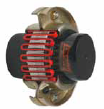The following details is necessary when producing a Grid coupling choice:
Description of motor or engine, the horse power (or KW), and RPM at slowest coupling pace even though below load
Description from the driven equipment
Shaft and keyway sizes plus the sort of match for driver and driven equipment (clearance or interference)**
Shaft separation (BSE)
Physical room limitations (see Application Worksheet)
Figure out what the environmental disorders will be, this kind of as temperature, corrosive situations, interference from surrounding structures, etc.
By default, sizes 1020 – 1090 will probably be clearance match, sizes 1100 – 1200 will likely be interference match.
** Machines all bores and keyways to meet the dimensional and tolerance specifications per ANSI/AGMA 9002-B04 for inch bores, or ISO 286-2 for metric  bores.
bores.
Normal grid couplings include two grid hubs, a grid spring, in addition to a cover assembly. When the shaft separation requires a spacer fashion coupling, the coupling will include two shaft hubs, two spacer hubs, a grid spring, in addition to a horizontal cover assembly.
Formulas Used To Calculate Torque:
Application Torque (in-lbs) = ( horse power x 63025 ) /RPM
Application Torque (Nm) = ( horse electrical power x 9550 ) /RPM
Assortment Torque = Application Torque x Services Issue
High Peak Loads and Brake Applications
For applications wherever substantial peak loads or higher braking torques may very well be current, the next added details will probably be required:
Procedure peak torque and frequency
Duty cycle
Brake torque rating
The selection torque formula is similar to the formula shown over except the application torque needs to be doubled just before applying the service factor.
Application Torque (in-lbs) = ( horse electrical power x 63025 ) /RPM
Application Torque (Nm) = ( horse energy x 9550 ) /RPM
Choice Torque = two x Application Torque x Services Element
Techniques In Picking out A Grid Coupling
Stage one: Decide the application torque using the formula proven above.
Step two: Select the Services Aspect in the charts .
For applications not displayed utilize the chart shown on the proper. Identify the Assortment Torque utilizing the formula proven above.
Phase three: Using the choice torque as calculated, refer on the Performance Chart
Phase 4: Examine the maximum bore for the size chosen and ensure the required bore sizes don’t exceed the maximum allowable. If your demanded bore dimension is more substantial, phase up to the following dimension coupling and verify to view in case the bore sizes will match.
Phase five: Working with the selected coupling dimension, examine the bore and keyway sizes
Step six: Speak to your nearby industrial supplier with all the aspect numbers to place sizes with the charts for UPC portion numbers.
